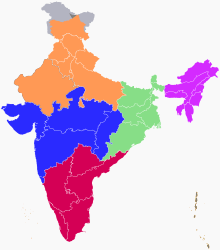National Grid (India)
The National Grid is the high-voltage electricity transmission network in mainland India, connecting power stations and major substations and ensuring that electricity generated anywhere in mainland India can be used to satisfy demand elsewhere.[1] The National Grid is owned, operated, and maintained by state-owned Power Grid Corporation of India. It is one of the largest operational synchronous grids in the world with 360.78 GW of installed power generation capacity on 31 August 2019.[2]

India's grid is connected as a wide area synchronous grid nominally running at 50 Hz. The permissible range of the frequency band is 49.95-50.05 Hz, effective 17 September 2012. The Union Government regulates grid frequency by requiring States to pay more when they draw power at low frequencies.[3] There are also synchronous interconnections to Bhutan, and asynchronous links with Bangladesh, Myanmar, and Nepal.[4] An undersea interconnection to Sri Lanka (India–Sri Lanka HVDC Interconnection) has also been proposed. A proposed interconnection between Myanmar and Thailand would facilitate the creation of a power pool and enable trading among all BIMSTEC nations.[5]
History
India began utilizing grid management on a regional basis in the 1961. Individual State grids were interconnected to form 5 regional grids covering mainland India. The grids were the Northern, Eastern, Western, North Eastern and Southern Grids. These regional links were established to enable transmission of surplus electricity between States in each region. In the 1990s, the Indian government began planning for a national grid. Regional grids were initially interconnected by asynchronous HVDC back-to-back links facilitating limited exchange of regulated power. The links were subsequently upgraded to high capacity synchronous links.[6]
The first interconnection of regional grids was established in October 1991 when the North Eastern and Eastern grids were interconnected. The Western Grid was interconnected with the aforementioned grids in March 2003. The Northern grid was also interconnected in August 2006, forming a Central Grid synchronously connected operating at one frequency.[6] The sole remaining regional grid, the Southern Grid, was synchronously interconnected to the Central Grid on 31 December 2013 with the commissioning of the 765 kV Raichur-Solapur transmission line, thereby establishing the National Grid.[7][6]
Territories outside the grid
The union territories of Andaman and Nicobar Islands and Lakshadweep are not connected to the National Grid. Both territories are archipelagos located far away from the mainland.[8] Due to the geography and topography of these islands, including separation by sea over great distances, there is no single power grid for all the electrified islands in the archipelago. The power generation and distribution systems of these territories is served by standalone systems, with each electrified island in the archipelago having its own generation and distribution system. Power stations cater independently to the power requirements of an area.[9][10] The Electricity Department of Andaman and Nicobar (EDA&N) and the Lakshadweep Electricity Department (LED) are responsible for generation, transmission and distribution systems in these territories.[11]
Inter regional transmission capacity
The inter regional total transmission capacity (TTC) is 75,050 MW as on 31 March 2017.[12] However the available transmission capacity (ATC) on daily basis is not exceeding 35% of TTC and the actual usage is around 25%.[13][14] Due to inter regional transmission constraints, the cost of power purchases by every region in IEX is not always equal.[15] MoP has introduced a policy for nationwide single merit order power purchases from IEX to avoid costly power purchases by the Discoms.[16]
Cross border transmission links
India began cross-border electricity trade in the mid-1980s. India established 33 kV and 132 kV interconnections in radial mode from Bihar and Uttar Pradesh to Bhutan and Nepal respectively. The first interconnection with Bangladesh was commissioned in December 2013, connecting Baharampur with Bheramara. As of April 2017, there are 12 cross-border interconnections between India and Nepal. India became a net exporter of electricity for the first time in the 2016-17 fiscal year.[17]
Presently, India is importing electricity from Bhutan with synchronous transmission links while exporting power to Nepal, Bangladesh and Myanmar with asynchronous transmission links between the National Grid, and the electricity grids of these countries.[18]
References
- "Areas of national grid". Retrieved 19 October 2016.
- "All India Installed Capacity of Utility Power Stations" (PDF). Retrieved 7 July 2017.
- Bhaskar, Utpal. "CERC plans to further narrow frequency band for national grid". Livemint. Retrieved 2 December 2016.
- "Grid Security – Need For Tightening of Frequency Band & Other Measures" (PDF). Central Electricity Regulatory Commission. Retrieved 2 December 2016.
- "BIMSTEC needs a 'power tool'; here's why it is time for a green energy revolution". The Financial Express. 3 January 2017. Retrieved 27 May 2017.
- "One Nation-One Grid". Power Grid Corporation of India. Retrieved 2 December 2016.
- "Indian power system becomes largest operating synchronous grid in the world". The Times of India. Retrieved 2016-12-02.
- "Renewable Energy". Department of Electricity, UT of Lakshadweep. Archived from the original on 9 July 2016. Retrieved 2 December 2016.
- "Power Department". Andaman and Nicobar Administration. Retrieved 2 December 2016.
- "Power for All - Andaman and Nicobar" (PDF). Ministry of Power. Retrieved 2 December 2016.
- "DEPARTMENT AT A GLANCE". electricity.and.nic.in. Retrieved 2 December 2016.
- "Inter Regional Transmission Capacity" (PDF). Retrieved 2 July 2017.
- "Monthly ATC Inter Regional". Retrieved 2 July 2017.
- "NLDC Daily Reports – 2017-18". Retrieved 2 July 2017.
- "IEX Area Prices". Retrieved 2 July 2017.
- "Merit Order Despatch of Electricity". Retrieved 12 July 2017.
- "India becomes net exporter of power for the first time". Retrieved 2 April 2017.
- "Cross Border Trade of Electricity" (PDF). Retrieved 2 April 2017.